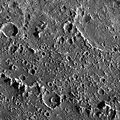Callisto
Template:unreferenced Template:Infobox Planet Callisto (kə-lis'-toe, Template:IPA2; Greek Καλλιστώ) is a moon of the planet Jupiter, discovered in 1610 by Galileo Galilei. It is the third-largest moon in the solar system, about 99% the size of the planet Mercury but much less massive.
Name
Callisto is named after Callisto, one of Zeus's many love interests in Greek mythology.
Although the name "Callisto" was suggested by Simon Marius soon after the moon's discovery, this name and the names of the other Galilean satellites fell into disfavour for a considerable time, and were not revived in common use until the mid-20th century. In much of the earlier astronomical literature, Callisto is simply referred to by its Roman numeral designation, Jupiter IV or as "the fourth satellite of Jupiter".
In scientific writing, the adjectival form of the name is usually Callistoan.
Physical characteristics
Internal Structure
Callisto's battered surface lies on top of an icy layer that is about 150 kilometers thick. A salty ocean in excess of 10 kilometers thick may lay beneath the crust. Its presence is indicated by studies of the magnetic fields around Jupiter and its moons. It was found that the Callistoan magnetic field varies (flows in various directions at different times) in response to the background magnetic field generated by Jupiter; this suggests a layer of highly conductive fluid within the moon.
Beneath the ocean, Callisto seems to have a strange interior that is not entirely uniform but does not vary dramatically. Galileo orbiter data suggest that the interior is composed of compressed rock and ice, with the amount of rock increasing with depth due to partial settling of its constituents. Callisto has the lowest density of the four Galilean moons of Jupiter, only 1.86 g/cm³, and is about 40% ice and 60% rock/iron.

Surface Features
Callisto is one of the most heavily cratered moons in the solar system. In fact, impact craters and associated concentric rings are about the only features to be found; there are no large callistoan mountains. This is probably due to the icy nature of its surface, with the largest craters and mountains being erased by the flow of the icy crust over geological time. Two enormous concentric ring impact basins are found on Callisto; Valhalla is the largest with a bright central region that is 600 kilometers in diameter and rings extending to 3000 kilometers in diameter, and the second-largest impact basin is Asgard measuring about 1600 kilometers in diameter. Another interesting feature is Gipul Catena, a long series of impact craters lined up in a straight line across Callisto's surface. This was probably caused by an object that was tidally disrupted as it passed close to Jupiter (much like Comet Shoemaker-Levy 9) before it impacted. Callisto's crust is thought to be approximately 4 billion years old, dating back almost to the formation of the solar system.
Unlike neighbouring Ganymede with its tectonic grooved terrain, there is little evidence of tectonic activity on Callisto. While Callisto is very similar in bulk properties to Ganymede, it apparently has a much simpler geological history. The different geologic histories of the two has been an important problem for planetary scientists. "Simple" Callisto is a good reference for comparison with other more complex worlds.
Atmosphere
Callisto has a very tenuous atmosphere composed of carbon dioxide[1]. Because such a thin atmosphere can easily be lost in a variety of ways (see atmospheric escape), scientists believe that it is constantly replenished, possibly by slow sublimation of carbon dioxide ice from the satellite's icy crust.
See also
- List of craters on Callisto
- List of geological features on Callisto
- The asteroid 204 Kallisto
- Colonization of Callisto
In fiction
- See Callisto in fiction.
Notes and references
- ↑ "Galileo spacecraft finds thin atmosphere on Callisto". Retrieved December 14, 2006.
Template:Moons of Jupiter
Template:Natural satellites of the Solar System (compact)
Template:Footer SolarSystem
als:Kallisto (Mond) frp:Calisto (satèlite) bs:Kalisto (mjesec) br:Kallisto (loarenn) bg:Калисто (спътник) ca:Cal·listo (satèl·lit) cs:Callisto (měsíc) co:Callistu da:Callisto (måne) de:Kallisto (Mond) es:Calisto (luna) eo:Kalistoo fr:Callisto (lune) ko:칼리스토 (위성) hr:Kalisto (mjesec) it:Callisto (astronomia) he:קליסטו (ירח) ka:კალისტო (თანამგზავრი) la:Callisto (satelles) lv:Kallisto (pavadonis) lt:Kalista (palydovas) hu:Callisto (hold) nl:Callisto (maan) ja:カリスト (衛星) no:Callisto (måne) nn:Jupitermånen Callisto pl:Kallisto (księżyc) pt:Calisto (satélite) ro:Callisto ru:Каллисто (спутник Юпитера) sk:Kallisto (mesiac) sl:Kalisto (luna) fi:Kallisto sv:Callisto tr:Callisto (uydu) zh:木卫四
 | This natural satellite related article is a stub. You can help Orbiterwiki by expanding it.
|
